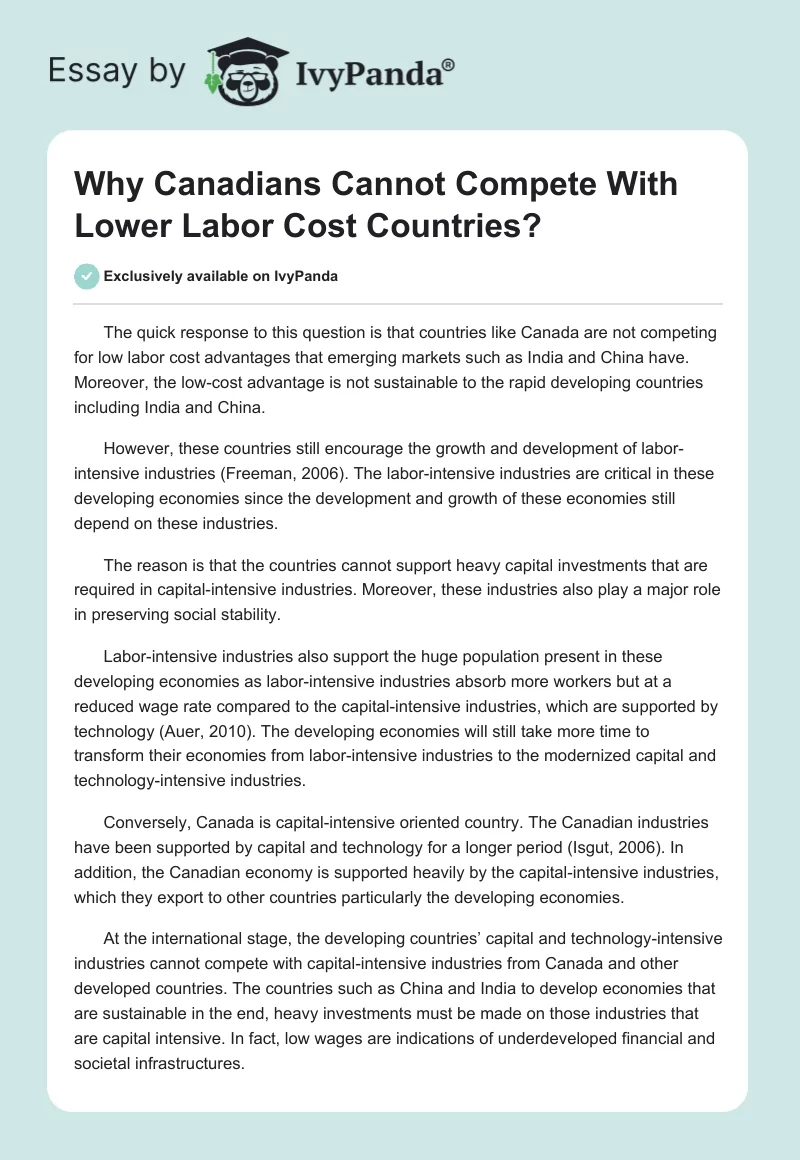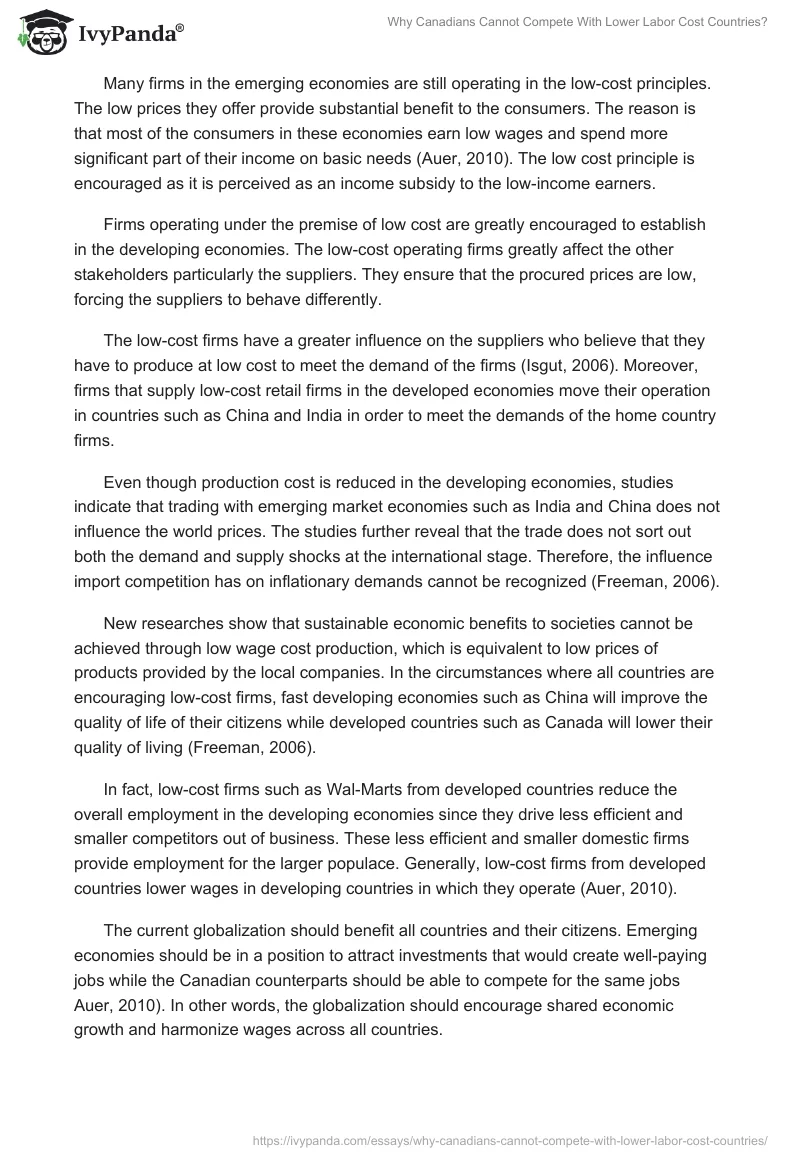The quick response to this question is that countries like Canada are not competing for low labor cost advantages that emerging markets such as India and China have. Moreover, the low-cost advantage is not sustainable to the rapid developing countries including India and China.
However, these countries still encourage the growth and development of labor-intensive industries (Freeman, 2006). The labor-intensive industries are critical in these developing economies since the development and growth of these economies still depend on these industries.
The reason is that the countries cannot support heavy capital investments that are required in capital-intensive industries. Moreover, these industries also play a major role in preserving social stability.
Labor-intensive industries also support the huge population present in these developing economies as labor-intensive industries absorb more workers but at a reduced wage rate compared to the capital-intensive industries, which are supported by technology (Auer, 2010). The developing economies will still take more time to transform their economies from labor-intensive industries to the modernized capital and technology-intensive industries.
Conversely, Canada is capital-intensive oriented country. The Canadian industries have been supported by capital and technology for a longer period (Isgut, 2006). In addition, the Canadian economy is supported heavily by the capital-intensive industries, which they export to other countries particularly the developing economies.
At the international stage, the developing countries’ capital and technology-intensive industries cannot compete with capital-intensive industries from Canada and other developed countries. The countries such as China and India to develop economies that are sustainable in the end, heavy investments must be made on those industries that are capital intensive. In fact, low wages are indications of underdeveloped financial and societal infrastructures.
Many firms in the emerging economies are still operating in the low-cost principles. The low prices they offer provide substantial benefit to the consumers. The reason is that most of the consumers in these economies earn low wages and spend more significant part of their income on basic needs (Auer, 2010). The low cost principle is encouraged as it is perceived as an income subsidy to the low-income earners.
Firms operating under the premise of low cost are greatly encouraged to establish in the developing economies. The low-cost operating firms greatly affect the other stakeholders particularly the suppliers. They ensure that the procured prices are low, forcing the suppliers to behave differently.
The low-cost firms have a greater influence on the suppliers who believe that they have to produce at low cost to meet the demand of the firms (Isgut, 2006). Moreover, firms that supply low-cost retail firms in the developed economies move their operation in countries such as China and India in order to meet the demands of the home country firms.
Even though production cost is reduced in the developing economies, studies indicate that trading with emerging market economies such as India and China does not influence the world prices. The studies further reveal that the trade does not sort out both the demand and supply shocks at the international stage. Therefore, the influence import competition has on inflationary demands cannot be recognized (Freeman, 2006).
New researches show that sustainable economic benefits to societies cannot be achieved through low wage cost production, which is equivalent to low prices of products provided by the local companies. In the circumstances where all countries are encouraging low-cost firms, fast developing economies such as China will improve the quality of life of their citizens while developed countries such as Canada will lower their quality of living (Freeman, 2006).
In fact, low-cost firms such as Wal-Marts from developed countries reduce the overall employment in the developing economies since they drive less efficient and smaller competitors out of business. These less efficient and smaller domestic firms provide employment for the larger populace. Generally, low-cost firms from developed countries lower wages in developing countries in which they operate (Auer, 2010).
The current globalization should benefit all countries and their citizens. Emerging economies should be in a position to attract investments that would create well-paying jobs while the Canadian counterparts should be able to compete for the same jobs Auer, 2010). In other words, the globalization should encourage shared economic growth and harmonize wages across all countries.
In fact, shared economic growth should encourage fair competition for employment opportunities. The shared economic growth should not protect the working developed countries citizens such as Canada from competing with fellow workers in the developing economies due to reduced wages (Isgut, 2006).
Fair competition in employment opportunities can be encouraged through liberalized trade. In addition, individual and corporate tax cuts should be encouraged to enable Canadian citizens to compete in the world labor market.
Canada has been trading with other countries around the world. The country has the opportunity to sell its products to over 8.7 billion people around the world. In other words, Canada has opened its doors to trade with any country around the world. In this context, trade involves both imports and exports (Isgut, 2006).
Therefore, Canada has the prospect of buying the products from other countries and selling its products to the world population. However, the current Chinese economic revival poses a great danger to both economies.
Competing with the economic giants that are producing at low cost due to reduced wages is challenging to the developed economies such as Canada. Therefore, developing countries must find ways in which they can properly manage they’re disrupted economic and social infrastructures (Isgut, 2006). Currently, countries are interdependent.
The benefits countries draw from each other are based on the mutual respect and agreements they have with each other. However, social and economic dislocations are not only found in the developing economies, but also in developed economies including Canada.
Dealing with these dislocations requires a highly structured procedure. Most importantly, countries should take advantage of their comparative advantage and find ways through which they can complement one another (Freeman, 2006).
The Canadian authorities should deal with protectionist policies that reduce the Canadian competitiveness within the global arena. The economic slowdowns of many countries have been attributed to protectionist policies. Conversely, free trade has been found to encourage economic growth.
Therefore, for Canada to remain competitive within the global arena, they have to continue pursuing the liberalized trade policies (Freeman, 2006). Canada hugely dependent on trade with other countries and therefore, its economic recovery relies on free trade while looking for more trading opportunities.
The Canadian economic output has slowed within the last four years compared to that of China and India. However, consumer spending in Canada is still bigger than the two economies. The huge consumer spending is estimated to be at low levels this economic year because of the increased public debt and the global economic slump (Freeman, 2006).
Under these conditions, the country needs to put more investments in the exporting industries to increase the levels of imports, which will foster economic growth (Isgut, 2006). The exporting industries must have a competitive advantage over the low wage industries from China and India.
Canada also needs to come up with new innovative policies that will increase its labor force competitiveness within the world labor market. The economic policy reforms should also be geared towards benefitting all. Most importantly, the labor market should be structured in a way that wages are at the same level as the rest of the world (Freeman, 2006). This will, in turn, increase the competitiveness of the local industries.
The Canadian firms should be encouraged to observe the rights of workers that enable them directly gain some share of the profits the firm makes through their trade unions (Auer, 2010).
Restructuring the labor market would require putting in place higher minimum wages, ensuring that social services are available to the workers and increasing the income tax credit. Since the global labor force has doubled currently, workers are supposed to have social support to remain competitive with the rest of the worker force around the globe (Freeman, 2006).
Collaborating with the rest of the world particularly incorporating and offering training to individuals and corporations on the financial best practices is critical for the development and growth of the economy (Isgut, 2006).
With the looming global economic slump, putting in place and adhering to ethical standards that are founded on the shared benefits for all the stakeholders will automatically lead to the growth of the economies, which in turn will lead to the improvement of the living standards of all individuals.
Canada is well positioned to lead towards this new global error. The world should have no place for low-cost firms such as Wal-Mart and low wage countries including China and India (Freeman, 2006). The world economy should move forward as one.
Freeman (2006) argues that low wage countries including China and India should be able to close the wage gap with those of developed economies such as that of US and Canada. The gap should not only be closed on the wages paid to the workforce but also on technological competence (Freeman, 2006).
The engineers, technicians, scientists, and entrepreneurs from the developing nations should be able to develop new products that benefit the global economy. Through this process, the general global cost of production decreases while improving the declining trade terms in the developed economies. Moreover, the increased production will result in the improvement of global living standards (Freeman, 2006).
At the current situation, the developed economies will still have a comparative advantage on several leading sectors particularly those that are supported by technology and heavy capital investments (Freeman, 2006). However, as the economies of the rapidly developing countries continue to expand, the global savings rate increases leading to the enlarged capital-labor ratio.
The increased GDP is distributed in the form of social services and infrastructure to the people. For instance, larger populations or labor force are covered by health insurance policies. The income tax credits can also be expanded through increased earnings. The improved social infrastructure is aimed at improving the living standards of all workers including those with very low wages (Freeman, 2006).
References
Auer, R. (2010). The effect of low-wage import competition on the inflationary pressure. Journal of Monetary Economics, 491(21), 503-513.
Freeman, R. (2006). The great doubling: the challenge of the new global labor market. Berkeley, CA: University of Berkeley.
Isgut, A. (2006). The effects of imports from China on the Canadian labor market: your wages are not set in Beijing. Toronto: University of Toronto.


